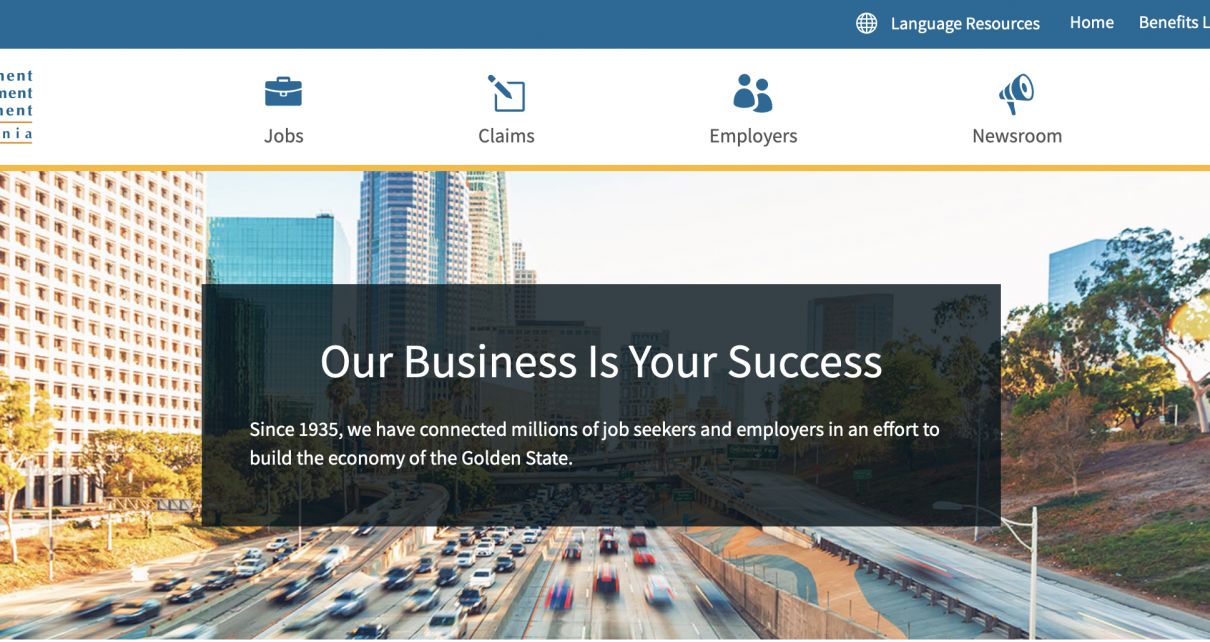
EDD website. (Photo: EDD.ca.gov)
GLOBE EXCLUSIVE – EDD Has Paid Billions to Feds in Interest Alone
In the past 10 years the state has managed to not borrow to cover unemployment claims only twice
By Thomas Buckley, December 3, 2022 7:52 am
Since 1990, California’s unemployment agency – the EDD – has paid the feds $1,793,665,930 in interest alone to help keep its doors open and claimants paid.
That approximately $1.8 billion dollar figure does not include what the state currently owes in interest – another $48.8 million for this year so far as the agency has begun borrowing again, as the Globe reported here – nor is that figure adjusted for inflation to reflect value in current dollars.
The inflation-adjusted number is significantly larger, approaching an estimated $3 billion.
Not only does the loss of this literally wasted money contribute to the inability of the state unemployment trust fund to build a solid footing and has made reform of the agency more difficult, but it has also had to be paid for by state employers and workers, driving up business costs and being a general drag on the state’s economy.
In the past 10 years – well before the pandemic – the state has managed to not borrow to cover unemployment claims only twice – in 2019 and 2020. In that same time period, the EDD has paid $1.2 billion in interest, about $817 million from 2013 to 2018 and another $330 million this year.
Just since 2007, the state has borrowed $100 billion and since 2013 up to and including this year the EDD has paid about $1.2 billion in interest (the other $600 million interest paid occurred on borrowing between 1990 and 2007.)
It should be noted that much of the specifically-pandemic-related billions lent to the EDD were loaned interest free (as they were to every state.)
On top of this, the state – as of midnight Thursday night – now owes another $18,223,379,798.78 in principal and another $48,846,063.38 (as noted above) in interest.
EDD’s debt-reliant funding is somewhat analogous to a person who has a credit card, runs it up to the, say, $5,000 limit, pays the minimum due, say $200, and then the next day spends $200 using the same card. Or it’s like borrowing $100 from a loan shark on the condition of paying $125 back next week but only paying the $25 “vig” week in and week out in order to keep the use of your knees (luckily for all involved, it is doubtful that the Social Security Administration – which administers the loan program – would send its goons to the EDD’s Sacramento offices to “collect.”)
It should be noted that the feds do not refuse to lend the money and tend to consider state (borrower)-initiated payment plans in order to make sure unemployment benefits claimants actually get the money they are entitled to. In other words, no matter the debt the money will flow through the EDD to the laid-off worker, as it does today.
It is true that the EDD has managed to occasionally pay the principal down to zero, but that state of being “off the schnide” is far from the typical condition of the financial affairs of the agency.
Like all states, California is allowed to borrow from a program called Title XII, a part of the Social Security system set up decades ago to “backstop” unemployment agencies experiencing what are supposed to be temporary difficulties. For example, a textile-heavy state that sees its mill jobs disappear and shipped overseas can access the funds to meet the concomitant spike in demand for benefits.
Unlike many other states, California must pay interest. Notably, which states pay interest varies from year to year, though California has not managed to qualify for interest-free money since 1990. The number of states that do qualify is usually between 20 and 28, or about half on the money it borrows, at a rate that has ranged over the years from about 1.7% to 2.5%.
The amount paid in interest – interest that brings no other gain along with it, like a mortgage leads to homeownership – could have funded a number of Governor Newsom’s pet green projects. For example, at $100 million a year (averaged and adjusted for inflation), the interest paid could have switched the funding of the state’s “methane satellites” program from just a one-off expense of $100 million this year to a dedicated annually funded project – not that that would be a good idea and, yes, methane satellites are exactly what they sound like – the state budgeted $100 million to help launch satellites dedicated to detecting methane emissions – basically, cows with the vapors; for more on this see here.
The state has one of the highest unemployment tax rates in the country, but, problematically, the lowest “base” rate possible. Taxes are paid on only the first $7,000 of income per employee, meaning the part-time intern costs the same to insure as the CEO even though the amount in benefits they would receive if laid off are wildly different. The state has not changed this base rate in about 50 years, while the benefits offered have risen dramatically since.
Additionally, the rates employers pay vary depending upon whether or not they have had significant layoffs and other similar issues that strain the unemployment system; “stable” employers can expect to pay only about one-third the rate of “problematic” ones, but the interest obligation to the feds is essentially paid equally by everyone.
“I think what policymakers may not realize is that the (interest) from Title XII loans also increases taxes on employers,” said Audrey Guo, Assistant Professor of Economics at Santa Clara University. “And these surcharges are less equitable because they penalize all California employers, even those that may not have previously laid off employees.”
Rationalizing the current tax and base rate numbers, said Guo, could “increase the tax cost for employers at the minimum and maximum, but other employers would actually experience tax rate decreases.”
As to why this problem has continued for more than 30 years, it is not clear, though it is possible that EDD employees know they can’t get fired for incompetence nor be rewarded for innovating changes.
“I’m not sure why California has lagged behind other states,” said Andrew Johnston, assistant professor of economics at UC-Merced. “But California’s largesse in some areas has meant that it doesn’t do basic service on the core of its social safety net, including its dilapidated education system and its bankrupt unemployment insurance program,”
As is its wont, the EDD did not reply to the Globe’s request for comment.
For the secret accountant in all of us, feel free to check out the federal unemployment trust fund solvency reports back to 2014 here: https://oui.doleta.gov/unemploy/solvency.asp
And you can track the EDD’s debt daily here: https://fiscaldata.treasury.gov/datasets/ssa-title-xii-advance-activities/advances-to-state-unemployment-funds-social-security-act-title-xii
- Benefit Fraud Problems and Solutions - November 7, 2024
- A Little Exit Poll - November 5, 2024
- Tomorrow’s Headlines Today! - November 5, 2024





But, but, but Noisome told me that everything was peachy keen and the state had billions in reserve.
Yeah, California has like an $80 billion surplus. Newsome told us so.
The base rate is an important issue, but I hope they put in a floor rate: exempt the first $3000 from SUI then kick it in for $3000-$10,000. The current system penalizes temporary and seasonal employers whose temporary employees rarely are able to claim benefits.
Suppose you are a seasonal pumpkin patch and hire some employees for the month of October who work for three weeks and then are laid off. It raises the cost of pumpkins for no public benefit. Likewise, suppose you are a ballet company that hires 50 members of an orchestra to perform The Nutcracker. You’re stuck paying 6.2% on all those orchestra members, raising Nutcracker ticket prices.
WHAT A MESS.